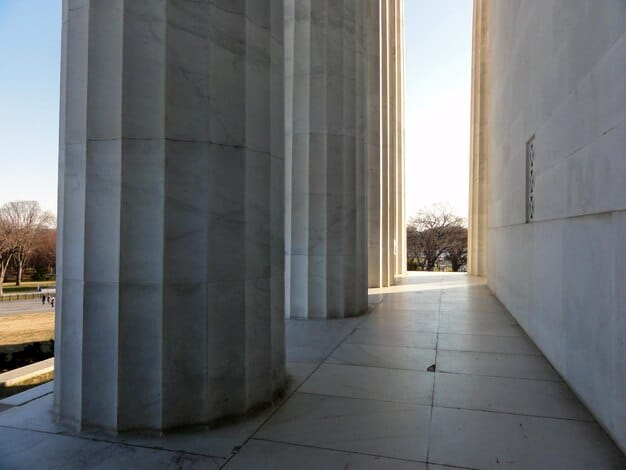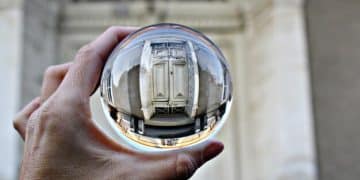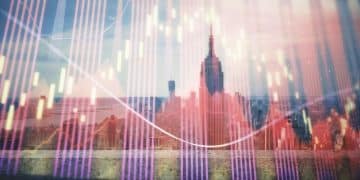US Supreme Court Term: Key Cases to Watch for Legal Insights

The upcoming US Supreme Court term is poised to tackle pivotal legal questions impacting American society, ranging from environmental regulations and gun rights to administrative power and corporate liability, demanding close attention from observers.
As the legal calendar turns, the US Supreme Court: What Are the Key Cases to Watch in the Upcoming Term? is a pressing question for anyone interested in significant shifts within American law and society. Each term brings forth a fresh slate of cases that can reshape fundamental rights, governmental powers, and the fabric of daily life for millions across the nation. Understanding these pivotal legal battles offers a crucial glimpse into the country’s evolving jurisprudence.
Understanding the Supreme Court’s Role and Process
The Supreme Court stands as the highest judicial body in the United States, primarily serving as an appeals court. It holds the ultimate authority in interpreting the U.S. Constitution and federal laws. Its decisions profoundly influence American society, setting precedents that all lower courts must follow.
The Court’s Unique Function
The Court’s role is unique, as it does not hear every case presented to it. Instead, it selects a limited number of cases each year, typically those that raise significant constitutional questions or involve conflicts between lower courts. This selective process ensures that the Court focuses on issues with broad national importance. The justices meticulously review petitions for writs of certiorari, ultimately deciding which cases warrant their attention.
- Judicial Review: The power to declare laws unconstitutional.
- Final Appeals: The last resort for legal challenges in the federal system.
- Precedent Setting: Decisions create binding rules for future cases.
Beyond its interpretive function, the Court also shapes governmental powers, defining the boundaries between federal authority and state sovereignty. Its rulings can impact electoral processes, civil liberties, and economic regulations. The nine justices, appointed for life, bring diverse legal philosophies to their deliberations, often leading to closely divided decisions that reflect the nation’s own ideological diversity. This intricate process underscores the Court’s enduring influence on the American legal landscape.
The Court’s term typically begins on the first Monday in October and continues until late June or early July of the following year. During this period, the justices hear oral arguments, review legal briefs, and engage in extensive deliberations before issuing opinions. Each decision, carefully crafted and debated, contributes to the evolving tapestry of American law, shaping precedents that endure for decades.
Key Cases Highlighting Administrative Power and Regulation
The upcoming term is anticipated to feature several cases that closely examine the scope of administrative power and governmental regulation. These cases are particularly significant as they could redefine the authority of federal agencies, impacting various sectors from environmental protection to economic policy. The Court’s stance on these challenges will send clear signals regarding the balance of power between the legislative, executive, and judicial branches.
Chevron Deference and its Future
One of the most closely watched areas involves challenges to the long-standing “Chevron deference” doctrine. This principle, established in the 1984 case of Chevron U.S.A., Inc. v. Natural Resources Defense Council, Inc., requires courts to defer to federal agencies’ reasonable interpretations of ambiguous statutes they administer. Its potential weakening or overturning could drastically alter how agencies operate and how regulations are enforced.
For decades, Chevron deference has been a cornerstone of administrative law, providing a framework for judicial review of agency actions. Critics argue it grants too much power to unelected bureaucrats, while proponents contend it provides necessary flexibility for agencies to adapt regulations as circumstances evolve. The Court’s re-evaluation reflects a growing skepticism among some justices regarding the breadth of agency authority.
- Implications for Environment: Could impact EPA’s ability to set emission standards.
- Economic Policy: Affects how federal agencies regulate industries.
- Separation of Powers: Realigns authority between branches of government.
The impact extends beyond the environment. Agencies like the Securities and Exchange Commission (SEC), the Federal Communications Commission (FCC), and the Food and Drug Administration (FDA) all rely on their interpretive authority to carry out their missions. A shift away from Chevron deference could usher in an era where courts scrutinize agency rules more stringently, potentially leading to increased litigation and uncertainty for regulated entities.  This potential restructuring of administrative law not only affects how regulations are formulated but also how they are challenged and reviewed by the judiciary, leading to a profound transformation in the regulatory landscape.
This potential restructuring of administrative law not only affects how regulations are formulated but also how they are challenged and reviewed by the judiciary, leading to a profound transformation in the regulatory landscape.
Environmental Law: Major Rulings on Climate and Water
Environmental protection stands as a critical area where the Supreme Court’s upcoming decisions are expected to have considerable implications. Cases in this domain often involve complex scientific and legal issues, balancing economic development with ecological preservation. The Court’s approach to these matters, especially concerning climate change and water rights, will shape future regulatory frameworks and conservation efforts across the nation.
The Court has recently shown a willingness to curtail federal agencies’ authority on environmental matters, signaling a potential shift in how environmental laws are interpreted and enforced. This trend could continue, impacting landmark legislation and the ability of agencies like the Environmental Protection Agency (EPA) to implement broad environmental policies. Observers are particularly keen on cases that touch upon the Clean Air Act and Clean Water Act, foundational pillars of U.S. environmental law.
The Balance Between Conservation and Resource Use
One key aspect often explored in environmental cases before the Court is the inherent tension between conservation goals and the commercial use of natural resources. This includes disputes over land development, mining, and energy production versus the protection of endangered species, wetlands, and clean air. The Court’s rulings frequently involve weighing competing interests and interpreting the reach of federal environmental statutes in these contexts.
For instance, cases may address the EPA’s authority to regulate greenhouse gas emissions from power plants or the federal government’s jurisdiction over “waters of the United States” under the Clean Water Act. These decisions are not merely technical; they have far-reaching practical consequences for industries, state governments, and environmental advocacy groups.
- Clean Water Act: Defining jurisdictional waters and wetlands.
- Climate Change: Limiting federal power to regulate emissions.
- Endangered Species Act: Balancing development with species protection.
The judiciary’s role extends to ensuring that environmental regulations are implemented constitutionally and do not overstep congressional intent. As such, the Court’s upcoming term is poised to deliver significant judgments that will either reinforce or restrict the government’s capacity to address pressing environmental challenges, directly influencing the nation’s ecological future and the legislative powers of Congress.
Second Amendment Rights: Emerging Interpretations
The Second Amendment, particularly its interpretation regarding the right to bear arms, remains a highly contentious area of law, frequently revisited by the Supreme Court. The upcoming term is likely to continue this trend, with cases that could further define the limits of gun ownership and the constitutionality of various firearm regulations. These cases often spark intense debate, reflecting the deep divisions within American society on gun control.
Following landmark decisions like District of Columbia v. Heller (2008) and New York State Rifle & Pistol Association, Inc. v. Bruen (2022), the Court has established an individual right to possess firearms for self-defense and clarified the historical test for assessing gun laws. This has led to a wave of challenges against existing regulations, from assault weapon bans to restrictions on carrying firearms in public spaces. The current conservative majority on the Court suggests a continued inclination towards expanding Second Amendment protections.
Challenges to Specific Gun Regulations
Cases under consideration might address specific types of firearms, such as commonly used semi-automatic rifles, or the regulations governing their sale and transfer. Another potential area of litigation involves “sensitive places,” where firearms might be restricted, or the requirements for obtaining concealed carry permits. The Court’s readiness to weigh in on these detailed applications of the Second Amendment indicates its commitment to shaping gun policy.
Lower courts have been grappling with the Bruen decision’s “historical tradition” test, leading to varied interpretations and conflicting rulings. The Supreme Court’s involvement would aim to provide clearer guidance, influencing how state and federal legislatures can enact gun safety measures moving forward. The outcome of these cases will have profound implications for both gun owners and those advocating for stricter gun control laws.
- Assault Weapons: Defining the legality of specific firearm types.
- “Sensitive Places”: Clarifying where firearms can be restricted.
- Licensing Requirements: Revisiting standards for gun permits.
Each decision will not only establish new precedents but also influence the legislative landscape, potentially leading to new laws or the overturning of existing ones. The intricate balance between Second Amendment protections and public safety remains a central theme in these deliberations, making these cases some of the most impactful of the term. The Court’s rulings will undoubtedly resonate throughout the nation, affecting countless individuals and gun rights advocacy groups.
Social Issues: Voting Rights, Free Speech, and Beyond
The Supreme Court frequently grapples with cases that directly touch upon deeply divisive social issues, encompassing matters of voting rights, free speech, religious freedom, and more. The upcoming term is expected to continue this trend, with the potential for significant rulings that could reshape fundamental civil liberties and societal norms. These cases are often emotionally charged and reflect the ongoing cultural debates within the United States.
Voting rights remain a perennial concern, with cases often challenging election procedures, redistricting maps, or voter ID laws. The Court’s interpretations of the Voting Rights Act and the Constitution’s equal protection clause directly influence the accessibility and fairness of the electoral process. Similarly, cases involving the First Amendment—covering issues from political expression and online speech to religious accommodation—continually test the boundaries of constitutional protections in a rapidly evolving society.
Religious Freedom and Conscience Protections
Another area consistently surfacing before the Court involves the interplay between religious freedom and anti-discrimination laws. These cases often require the justices to balance the rights of individuals and organizations to exercise their religious beliefs against broader societal interests, such as ensuring equal treatment for all citizens. Recent terms have seen the Court generally favor religious claimants, suggesting a potential continuation of this trend.
Disputes may arise from attempts to exempt certain religious practices from general laws or challenges to regulations that religious organizations perceive as infringing on their autonomy. The Court’s decisions in this sphere have implications for healthcare, employment, and public accommodations, reflecting the ongoing effort to define the scope of religious liberty in a diverse nation.
- Electoral Process: Addressing challenges to voting procedures and state election laws.
- Online Speech: Clarifying the First Amendment’s reach in the digital age.
- Discrimination: Balancing individual rights with anti-discrimination principles.
These cases not only define legal parameters but also spark widespread public discussion, becoming benchmarks for the Court’s jurisprudential direction. The decisions can recalibrate the relationship between individual freedoms and governmental roles, making them some of the most closely observed rulings of any term.  The outcomes will have a lasting impact on how American society navigates its complex tapestry of rights and responsibilities.
The outcomes will have a lasting impact on how American society navigates its complex tapestry of rights and responsibilities.
Business and Corporate Law: Defining Liability and Regulation
The Supreme Court’s docket often includes cases that directly impact the business and corporate landscape, shaping frameworks for liability, regulation, and intellectual property. The upcoming term is anticipated to bring forth rulings that could have far-reaching consequences for industries, investors, and consumers, influencing everything from financial practices to product development. These cases often involve complex statutes and high-stakes economic implications.
Recent years have seen the Court address issues such as corporate responsibility, antitrust laws, and the scope of shareholder rights. Businesses closely monitor these decisions, as they can alter operating costs, compliance requirements, and potential legal exposures. The Court’s interpretations of federal statutes in this realm can either foster innovation and economic growth or impose new burdens that necessitate significant operational adjustments.
Securities Law and Investor Protection
A crucial area within business law that frequently reaches the Supreme Court involves securities regulation and investor protection. Cases in this category might deal with the extent of corporate disclosure obligations, the enforcement powers of the Securities and Exchange Commission (SEC), or the class action lawsuits filed by defrauded investors. The Court’s aim is often to balance the need to protect investors with the desire to avoid overly burdensome regulations on corporations.
For instance, a case might examine the legal standards for proving securities fraud or clarify the personal liability of corporate officers in financial misconduct cases. These decisions directly affect market stability, investor confidence, and the practical enforcement of capital market laws. Their outcomes can significantly influence how corporations raise capital and how financial markets operate.
- Antitrust Cases: Redefining market competition and monopolies.
- Intellectual Property: Clarifying patent and copyright enforcement.
- Consumer Protection: Limiting corporate liability for product defects.
Beyond securities, other business-related cases might involve labor relations, bankruptcy law, or the jurisdiction of federal courts over commercial disputes. Each ruling contributes to the broader legal environment in which businesses operate, either expanding or contracting their legal obligations and rights. The implications often extend across various sectors of the economy, making these judgments highly anticipated by legal and financial professionals alike. The outcomes will undoubtedly shape commercial practices and regulatory compliance in the years ahead.
Looking Ahead: The Court’s Impact on American Society
As the Supreme Court prepares for its new term, the collective weight of its upcoming decisions portends a significant impact on various facets of American society. The Court’s role as the ultimate arbiter of constitutional and federal law means that its judgments extend far beyond the legal community, influencing policies, rights, and daily life for millions. This broad influence ensures that each term is a critical period for observers and participants in the nation’s legal and political discourse.
The Court’s decisions, whether subtle shifts in legal interpretation or sweeping reversals of long-standing precedents, contribute to the dynamic evolution of American jurisprudence. The current composition of the Court, with its notable ideological leanings, suggests a continued emphasis on certain legal philosophies, potentially leading to more consistent rulings in specific areas such as religious freedom and the scope of federal power. This trajectory can redefine established norms and spark new legal challenges.
Beyond the specific legal outcomes, the Supreme Court’s proceedings offer a unique window into the nation’s ongoing conversations about fundamental values and rights. The cases selected often reflect the most pressing and contentious issues of the day, forcing a national dialogue on topics that resonate deeply with different segments of the population. This public engagement underscores the Court’s importance not just as a judicial body, but as a crucial institution in the nation’s democratic framework.
The Interplay of Law and Public Policy
The Court’s rulings often have immediate and direct consequences for public policy, even without immediate legislative action. For example, decisions on environmental regulations dictate the actions of federal agencies and industries, while rulings on voting rights can alter election processes nationwide. This direct link to policy ensures that the Court’s docket is always scrutinized by lawmakers, advocacy groups, and concerned citizens.
Furthermore, the Court’s pronouncements can stimulate legislative responses. When the Court curtails a particular power or overturns a law, Congress may respond by drafting new legislation designed to address the issues raised or to re-establish regulatory authority through different means. This legislative dialogue highlights the intricate system of checks and balances inherent in the U.S. government.
- Shaping Public Discourse: Decisions often drive national conversations on social issues.
- Legislative Response: Rulings can prompt new laws or amendments.
- Future Precedents: Laying groundwork for legal interpretations for decades.
Ultimately, the upcoming term of the Supreme Court is not just a series of legal cases but a series of moments that will collectively shape the direction of the country. From refining administrative law to redefining individual liberties, the Court’s work is essential to understanding the continuous evolution of American law and its deep impact on political, social, and economic life. Each decision contributes to the ongoing narrative of justice and governance in the United States.
| Key Area | Brief Impact |
|---|---|
| ⚖️ Administrative Power | Potential changes to agency authority and regulatory enforcement. |
| 🌍 Environmental Law | Rethinking climate and water regulations, affecting conservation efforts. |
| 🔫 Second Amendment | Further defining gun rights and the legality of various firearm restrictions. |
| 👔 Business & Corporate | Shaping rules on corporate liability, intellectual property, and investor protection. |
Frequently Asked Questions About the US Supreme Court Term
▼
Chevron deference is a legal principle where courts defer to federal agencies’ reasonable interpretations of ambiguous statutes. It’s crucial because if overturned or weakened, it could significantly limit agency power, impacting regulations across all sectors, from environmental to economic policy, requiring closer judicial scrutiny of agency actions.
▼
The Court’s previous rulings have expanded gun rights, using a “historical tradition” test for gun laws. Upcoming cases may further define the legality of specific firearms, restrictions in “sensitive places,” or concealed carry permit requirements. These rulings will influence how states and federal authorities can regulate firearms, affecting gun owners and public safety.
▼
Environmental cases often involve balancing conservation with resource use. The Court might hear challenges to the EPA’s authority over climate change regulations or federal jurisdiction under the Clean Water Act. These decisions are pivotal as they define the scope of government power to protect the environment and influence national ecological policies.
▼
The Supreme Court influences business through rulings on corporate liability, regulation, and intellectual property. High-stakes cases often address securities law, antitrust issues, or consumer protection. These decisions can alter compliance costs, investment confidence, and market stability, setting critical precedents for all commercial entities operating within the US legal framework.
▼
The Supreme Court’s decisions are foundational, interpreting the Constitution and federal laws with far-reaching impacts on rights, policies, and daily life. Each term shapes administrative powers, civil liberties, and economic frameworks, reflecting national debates. Its rulings not only set legal precedents but also drive public discourse and can prompt legislative responses, defining the nation’s future.
Conclusion
The upcoming term of the US Supreme Court promises to be a period of intense legal scrutiny and significant societal impact across a broad spectrum of issues. From the intricate questions surrounding administrative power and environmental regulations to the foundational debates on Second Amendment rights, social liberties, and corporate law, the Court’s decisions will undeniably shape the nation’s legal and social landscape for years to come. Understanding these key cases is crucial for anyone seeking to comprehend the evolving dynamics of American governance and the rights of its citizens.





